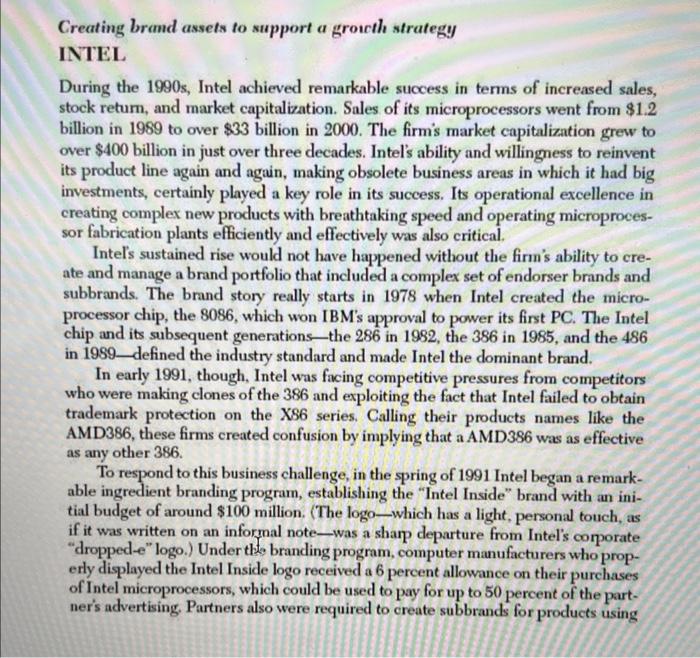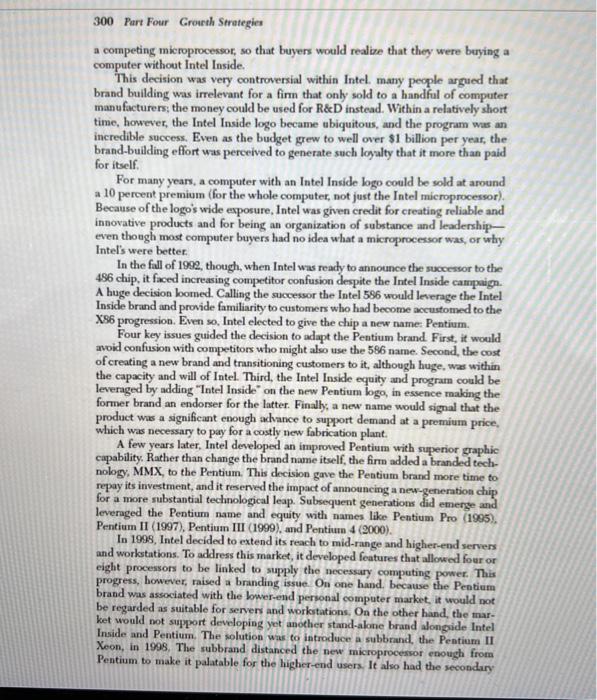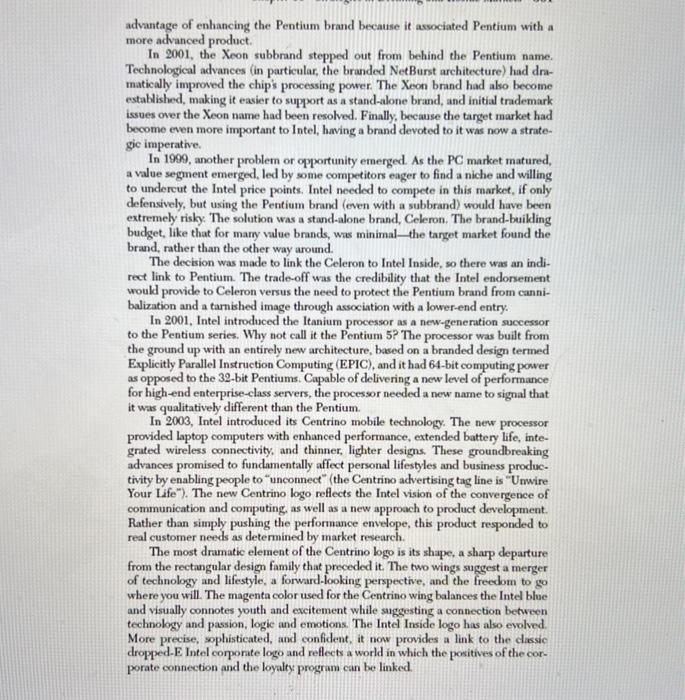INTEL During the 1990s, Intel achieved remarkable success in terms of increased sales, stock retum, and market capitalization. Sales of its microprocessors went from 81.2 billion in 1989 to over $33 billion in 2000 . The firm's market capitalization grew to over $400 billion in just over three decades. Intel's ability and willingness to reinvent its product line again and again, making obsolete business areas in which it had big investments, certainly played a key role in its success. Its operational excellence in creating complex new products with breathtaking speed and operating microprocessor fabrication plants efficiently and effectively was also critical. Intel's sustained rise would not have happened without the firm's ability to create and manage a brand portfolio that included a complex set of endorser brands and subbrands. The brand story really starts in 1978 when Intel created the microprocessor chip, the 8086 , which won IBM's approval to power its first PC. The Intel chip and its subsequent generations - the 286 in 1982 , the 386 in 1985 , and the 486 in 1959-defined the industry standard and made Intel the dominant brand. In early 1991, though, Intel was facing competitive pressures from competitors who were making clones of the 386 and exploiting the fact that Intel failed to obtain trademark protection on the XS6 series. Calling their products names like the AMD386, these firms created confusion by implying that a AMD386 was as effective as any other 386 . To respond to this business challenge, in the spring of 1991 Intel began a remarkable ingredient branding program, establishing the "Intel Inside" brand with an initial budget of around $100 million. (The logo - which has a light, personal touch, as if it was written on an informal note-was a sharp departure from Intel's corporate "dropped-e" logo.) Under the branding program, computer manufacturers who properly displayed the Intel Inside logo received a 6 percent allowance on their purchases of Intel microprocessors, which could be used to pay for up to 50 percent of the partner's advertising. Partners also were required to create subbrands for products using 300 Part Four Grouth Strategies a competing microprocessor, so that buyers would realize that they were buying a computer without Intel Inside. This decision was very controversial within Intel. many people argued that brand building was irrelevant for a firm that only sold to a handful of computer manufacturers; the money could be used for R&D instead. Within a relatively short time, however, the Intel Inside logo became ubiquitous, and the program was an incredible success. Even as the budget grew to well over $1 billion per year, the brand-building effort was perceived to generate such loyalty that it more than paid for itself. For many years, a computer with an Intel Inside logo could be sold at around a 10 percent premium (for the whole computer, not just the Intel microprocessor). Because of the logo's wide exposure, Intel was given credit for creating reliable and innovative products and for being an organization of substance and leadershipeven though most computer buyers had no idea what a microprocessor was, or why Intel's were better. In the fall of 1992, though, when Intel was ready to announce the successor to the 486 chip, it faced increasing competitor confusion despite the Intel Inside campaign. A huge decision bomed. Calling the successor the Intel 586 would leverage the Intel Inside brand and provide familiarity to customers who had become accustomed to the XS6 progression. Even so. Intel elected to give the chip a new name: Pentium. Four key issues guided the decision to adapt the Pentium brand First, it would avoid confusion with competitors who might also use the 586 name. Second, the cost of creating a new brand and tnansitioning customers to it, although huge, was within the capacity and will of Intel. Third, the Intel Inside equity and program could be leveraged by adding "Intel Inside" on the new Pentium logo, in essence rnalding the former brand an endorser for the latter. Finally, a new name would signal that the product was a significant enough advance to support demand at a premium price. which was necessary to pay for a costly new fabrication plant. A few years later, Intel developed an improved Pentium with superior graphic capability. Rather than change the brand name itself, the firm added a branded technology, MMX, to the Pentium. This decision gave the Peatium brand more time to repay its investment, and it reserved the impact of announcing a new-generation chip for a more substantial technological leap. Subsequent generations did emerge and leveruged the Pentium name and equity with names like Pentium Pro (1995). Pentium II (1997), Pentium III (1999), and Pentiun 4 (2000). In 1995, Intel decided to extend its reach to mid-range and higher-end servers and workstations. To address this market, it developed features that allowed four or eight processors to be linked to supply the necessary computing power. This progress, however, raised a branding issue On one hand. because the Pentium brand was associated with the bower-end personal computer market, it would not be regarded as suitable for servens and workstations. On the other hand, the market would not support developing yet another stand-alone brand alongide Intel Inside and Pentium. The solution was to introduce a subbrand, the Pentium II Xeon, in 1998. The subbrand distanced the new microprocessor enough from Pentium to make it palatable for the higher-end users. It also had the secondary advantage of enhancing the Pentium brand because it associated Pentium with a more advanced product. In 2001, the Xeon subbrand stepped out from behind the Pentium name. Technological advances (in particular, the branded NetBurst architecture) had dramatically improved the chip's processing power. The Xeon brand had also become established, making it easier to support as a stand-alone brand, and initial trademark issues over the Xeon name had been resolved. Finally, because the target market had become even more important to Intel, having a brand devoted to it was now a strategic imperative. In 1999, another problem or opportunity emerged. As the PC market matured, a value segnent emerged, led by some competitors eager to find a niche and willing to undercut the Intel price points. Intel needed to compete in this market, if only defensively, but using the Pentium brand (even with a subbrand) would have been extremely risky. The solution was a stand-alone brand, Celeron. The brand-building budget, like that for many value brands, was minimal - the target market found the brand, rather than the other way around. The decision was made to link the Celeron to Intel Inside, so there was an indirect link to Pentium. The trade-off was the credibility that the Intel endorsement would provide to Celeron versus the need to protect the Pentium brand from cannibalization and a tarnished image through association with a lower-end entry. In 2001, Intel introduced the Itanium processor as a new-generation successor to the Pentium series. Why not call it the Pentium 5 ? The processor was built from the ground up with an entirely new architecture, based on a branded design termed Explicitly Parallel Instruction Computing (EPIC), and it had 64-bit computing power as opposed to the 32-bit Pentiums. Capable of delivering a new level of performance for high-end enterprise-class servers, the processor needed a new name to signal that it was qualitatively different than the Pentium. In 2003, Intel introduced its Centrino mobile technology. The new processor provided laptop computers with enhanced performance, extended battery life, integrated wireless connectivity, and thinner, lighter designs. These groundbreaking advances promised to fundamentally affect personal lifestyles and business productivity by enabling people to "unconnect" (the Centrino advertising tag line is "Unwire Your Life"). The new Centrino logo reflects the Intel vision of the convergence of communication and computing, as well as a new approach to product development. Rather than simply pushing the performance envelope, this product responded to real customer needs as determined by market research. The most dramatic element of the Centrino logo is its shape, a sharp departure from the rectangular design family that preceded it. The two wings suggest a merger of technology and lifestyle, a forward-looking perspective, and the freedom to go where you will. The magenta color used for the Centrino wing balances the Intel blue and visually connotes youth and excitement while suggesting a connection between technology and passion, logic and emotions. The Intel Inside logo has also evolved. More precise, sophisticated, and confident, it now provides a link to the classic dropped-E Intel corporate logo and reflects a world in which the positives of the corporate connection and the loyalty program can be linked. QUESTIONS FOR SCW 5: 1. Evaluate the Centrino brand strategy. How will it help Intel be relevant to the mobile computing world? 2. What alternatives does a competitor such as AMD have to combat the Intel Inside branding strategy? - There is no minimum or maximum word limit for your answer. Do take as much space as needed to convey your point. - Your answer should be written in clear and concise language. - Please answer in full sentences. If you would like to use bullet points, please provide a context - i.e., your answer cannot comprise only bullet points. - Please ensure you proofread, copy-edit, and review your answers before submission











